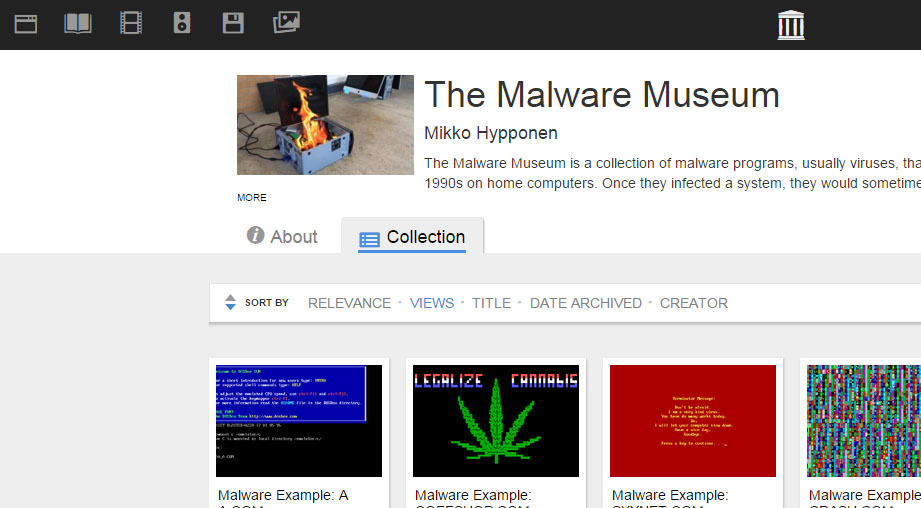
A very special museum has just opened its doors, albeit virtual ones. The gallery is online and its works aren’t paintings, nor sculptures, nor antiques: they are pieces of malware that during the 80s and 90s attacked the now defunct operating system MS-DOS (remember that?!).
The collection is hosted on the pages of the Internet Archive, the largest online library, and allows us to travel back in time to an era in which viruses were a new thing. As always, looking back on the past can help us learn in the present, even when it comes to IT security, as it helps us to see errors, solutions, and even tricks that we can apply to our present work.
Before stepping foot back in time, let’s reassure ourselves – the malware in this museum has been disabled by experts and can’t cause any harm now! Enjoy the journey without any fears over adverse effects.
So, here are things that we have learnt from the Malware Museum:
Viruses have existed for a long time…
It seems obvious, but younger people often forget how long different technology, and the associated risks and threats, have been around for. Malware has been infecting personal computers for the past 30 years, ever since the pioneering Brain for MS-DOS was developed by two Pakistani brothers. Of course, back then the objective of the malware was quite different.
… but shady business is a lot more recent.
Cybercrime mafias who today reap the benefits of data theft and computer kidnapping didn’t exist back then. The creators of viruses were introverted types who did it as a hobby or for fun, without the aim of a financial gain.
Malware wasn’t always so bad…
This is because money wasn’t at stake. By not looking for a profit with their creations, but rather personal satisfaction or infamy, the viruses were a lot less damaging for their victims. This, of course, doesn’t mean that they weren’t an annoyance all the same!
… but they were still pretty destructive
In fact, a lot of the malicious programs from the 80s and 90s that we can see in the Malware Museum left the infected computer unusable. They deleted the hard drive, placed a screen that was impossible to exit from, made working a nightmare… every annoyance possible. They may have had more innocent intentions, but they were still malware all the same.
It was easier to know if you were infected
Now the main objective for attackers is to go unnoticed by the victim, with it being a success for cyber-attackers if you don’t realize that there is a malware on your computer. However, in the past, the goal was to be as obvious as possible. Alarming sounds, bright colors, crazy animations… if you were a victim, it was impossible not to know about it. Nowadays it’s a totally different story.
Hackers were very creative…
In the effort to be noticed, many malware developers went full-on arty with their creations. In fact, many of the viruses that we can find in the museum could easily be used as screensavers.
… they also had a sense of humor
Overall, it seemed to be a game for them, and sometimes it literally was. One of the most unusual programs turned the victims’ computers into casinos. The victim had five chances to recover the information on the hard drive by playing a slot machine – if luck wasn’t on your side, you had a visit to a service technician waiting for you.
Viruses were a form of activism
Some malware developers used their works to defend causes in what we could consider a form of “hacktivism”. In this museum we can see, among other things, calls for a more equal world (praiseworthy, were it not a virus) or for the legalization of marijuana. There are even examples of fervent patriotism.
Famous films were a goldmine
If there is one thing which hasn’t changed over the years it has to be the old trick of taking advantage of big events (such as the release of a famous film) to make a larger number of victims download malware without knowing it. Recently, cybercriminals have used the release of Star Wars: The Force Awakens, but in the past there was already a virus that referenced the famous intergalactic saga. In the museum we can also find a malicious program that paid homage to The Lord of the Rings.
FOTO 3
The most important lesson: an antivirus has always been necessary
And it always will be. While there are viruses, users can only be safe if a good antivirus is there to protect them. Paradoxically, one of the malwares that we can see in the Internet Archive collection reminds us of this. So, there you have it – nearly all of the lessons that we must apply to the present have come from the past, you just need to know how to look for them.